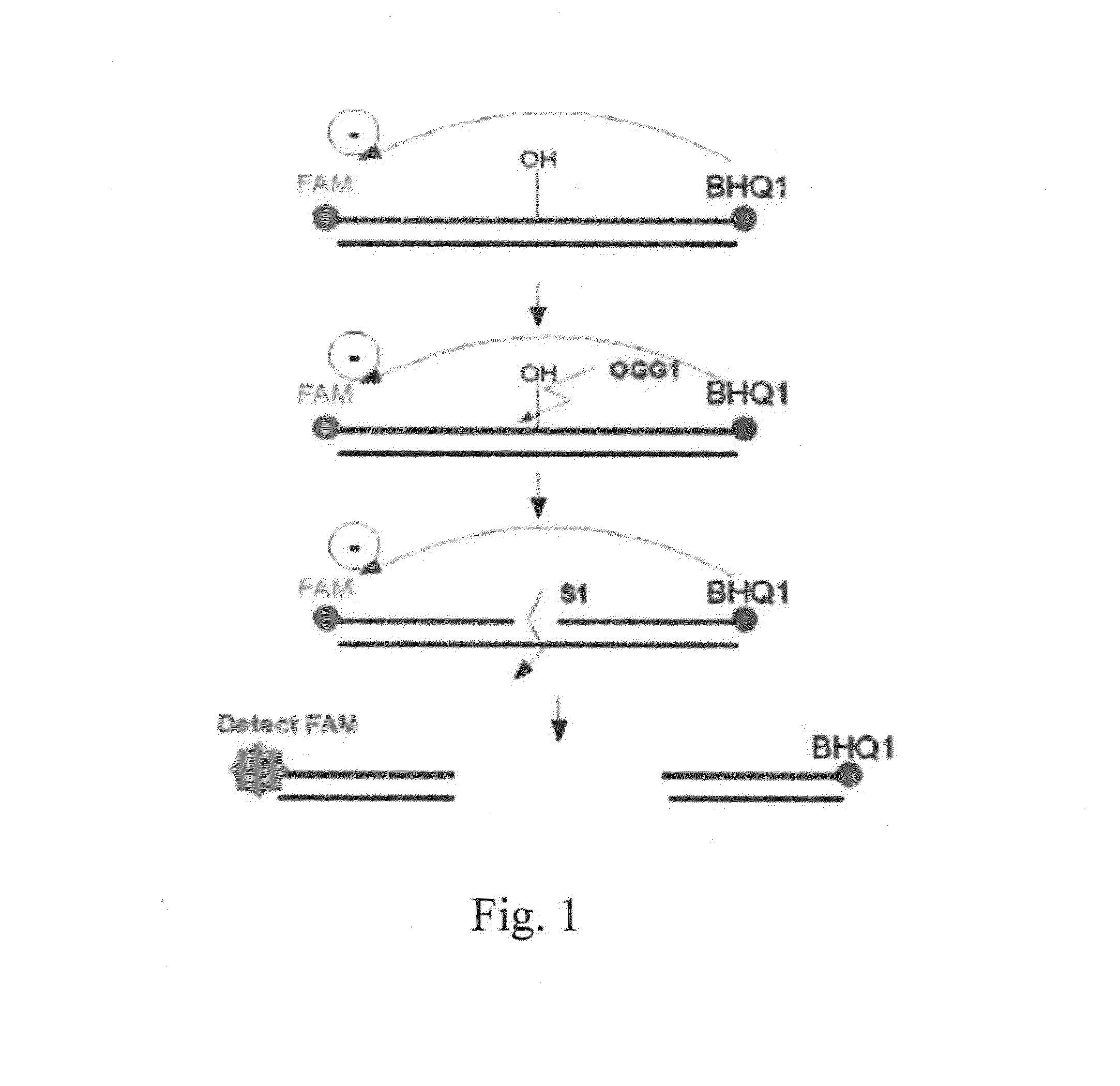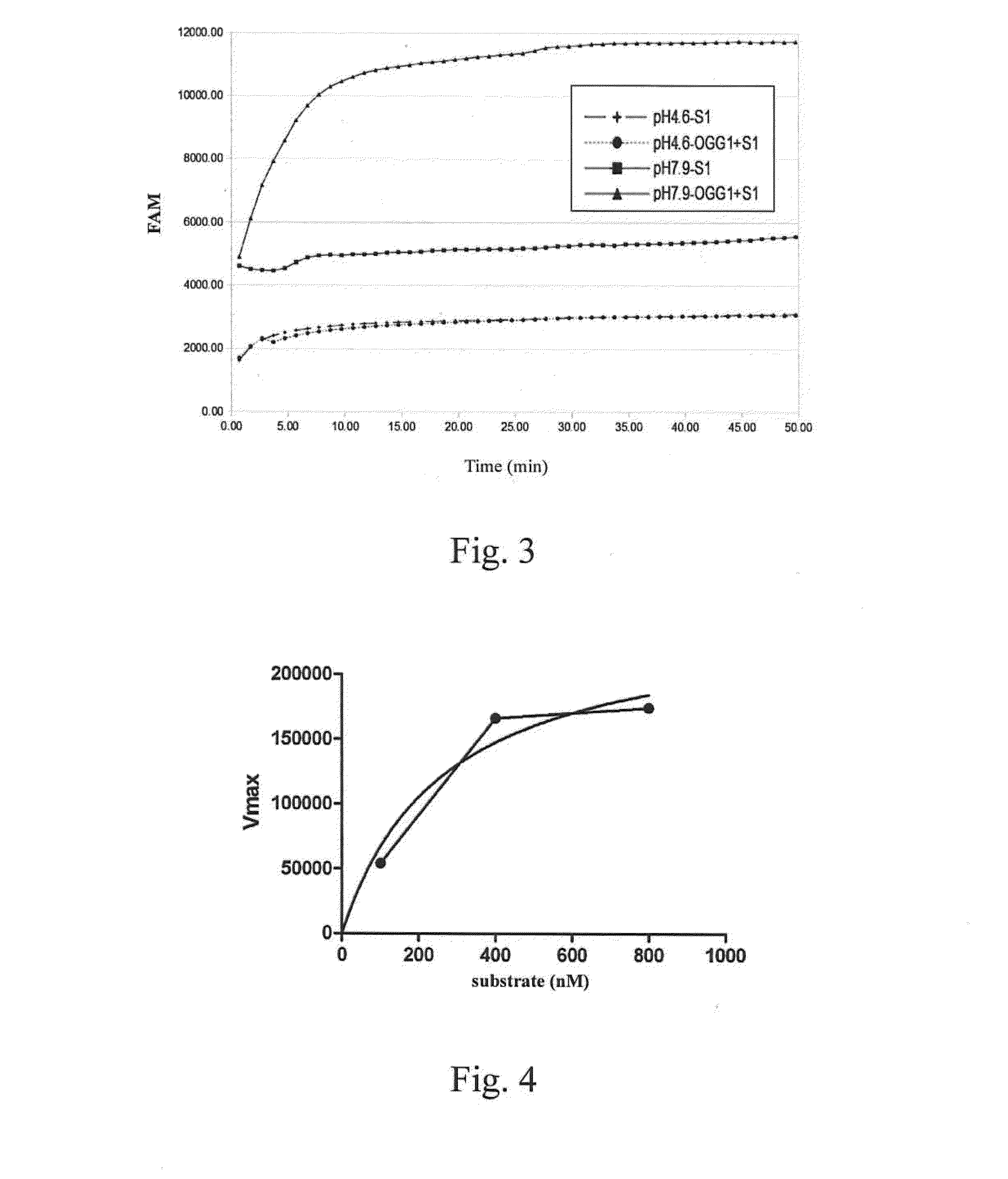Method for determining activity of nucleic-acid-repair enzyme
a nucleic acid and enzyme technology, applied in the field of determining the activity of a nucleic acid-repair enzyme, can solve the problems of reducing the activity of the nucleic acid-repair enzyme, increasing the risk of the subject's developing cancer (such as lung cancer and esophageal cancer), and generating mutated nucleotides
- Summary
- Abstract
- Description
- Claims
- Application Information
AI Technical Summary
Benefits of technology
Problems solved by technology
Method used
Image
Examples
preparation example 1
The Preparation of a Double-Stranded Nucleic Acid Molecule with 8-oxoG
[0033]A single-stranded DNA sequence: 5′-CATCGTTGTC[8-oxoG]CAGACCTGGTGGAT-3′ (SEQ ID NO: 1) was synthesized , wherein the [8-oxoG] was 8-oxoguanine. A single-strand DNA sequence complementary to SEQ ID NO: 1: 5′-CGGTATCCACCAGGTCTGCGACAACGATGAAGCC-3′ (SEQ ID NO: 2) was synthesized. A fluorophore 6FAM was labeled at the 5′ end of SEQ ID NO: 1 and a quencher BHQ1 was labeled at the 3′ end of SEQ ID NO: 1 by using a Taq Man Probe system. Subsequently, to make these two single-stranded DNA anneal to form a double-stranded DNA molecule, 400 nM of SEQ ID NO:1 which was labeled with 6FAM and BHQ1 and 800 nM of SEQ ID NO: 2 were mixed for reaction in a PCR machine (Eppendorf, Germany) at the following conditions: 95° C., 5 minutes for 1 cycle; 95° C. (decreasing by 5° C. per cycle), 1 minute for 7 cycles; 60° C., 30 minutes for 1 cycle; 60° C. (decreasing by 1° C. per cycle), 1 minute for 35 cycles. Then, a double-stranded...
preparation example 2
The preparation for a Double-Stranded Nucleic Acid Molecule with Uridylic Acid
[0034]A single-stranded DNA sequence: 5′-AGTCAGTCGAGCUCATTCAGT-3′ (SEQ ID NO: 3) was synthesized, wherein the “U” represents a uridylic acid. A single-strand DNA sequence: 5′- ACTGACTGAATGAGCTCGACTGACT-3′ (SEQ ID NO: 4) complementary to SEQ ID NO: 3 was synthesized. A fluorophore 6FAM was labeled at the 5′ end of SEQ ID NO: 3 and a quencher BHQ1 was labeled at the 3′ end of SEA ID NO: 3 by using a Taq Man Probe system. Subsequently, to make these two single-stranded DNA anneal to form a double-stranded DNA molecule, 400 of nM SEQ ID NO: 3 which was labeled with 6FAM and BHQ1 and 800 nM of SEQ ID NO: 4 were mixed for reaction in a PCR machine at the following conditions: 95° C., 5 minutes for 1 cycle; 95° C. (decreasing by 5° Cper cycle), 1 minute for 7 cycles; 60° C., 30 minutes for 1 cycle; 60° C. (decreasing by 1° C. per cycle), 1 minute for 35 cycles. Then, a double-stranded DNA molecule with a mutated ...
example 1
Determination of the Amount of S1 Nuclease Required for Determining the Activity of a Nucleic-Acid-Repair Enzyme
[0035]It has been known that an appropriate amount of S1 nuclease could be used to cut a single-stranded nucleic acid and a double-stranded nucleic acid at the site of the gap or abasic site. However, an excessive amount of S1 nuclease will cause S1 nuclease to erroneously cut a double-stranded nucleic acid. This example discussed the appropriate amount of S1 nuclease for determining the activity of a nucleic-acid-repair enzyme when using the double-stranded DNA molecule prepared in the Preparation Example 1.
[0036]Four hundred nM of the double-stranded DNA molecule with 8-oxoG prepared in the Preparation Example 1 and S1 nuclease (1 U, 2 U, 10 U, 20 U, or 30 U) were mixed. The fluorescence signals were measured in the case of with or without 1 U of OGG1, by using an iQ5 real-time qPCR analyzer (BioRad, USA) or an MRX fluorescence luminescence analyzer (Eppendorf, Germany) ...
PUM
| Property | Measurement | Unit |
|---|---|---|
| Length | aaaaa | aaaaa |
| Ratio | aaaaa | aaaaa |
| Fluorescence | aaaaa | aaaaa |
Abstract
Description
Claims
Application Information
 Login to View More
Login to View More - R&D
- Intellectual Property
- Life Sciences
- Materials
- Tech Scout
- Unparalleled Data Quality
- Higher Quality Content
- 60% Fewer Hallucinations
Browse by: Latest US Patents, China's latest patents, Technical Efficacy Thesaurus, Application Domain, Technology Topic, Popular Technical Reports.
© 2025 PatSnap. All rights reserved.Legal|Privacy policy|Modern Slavery Act Transparency Statement|Sitemap|About US| Contact US: help@patsnap.com



